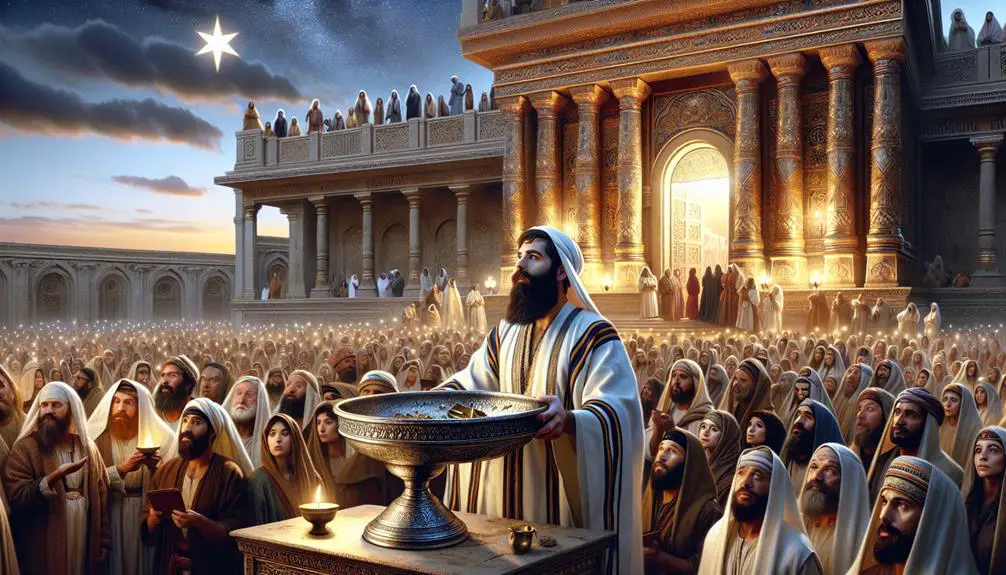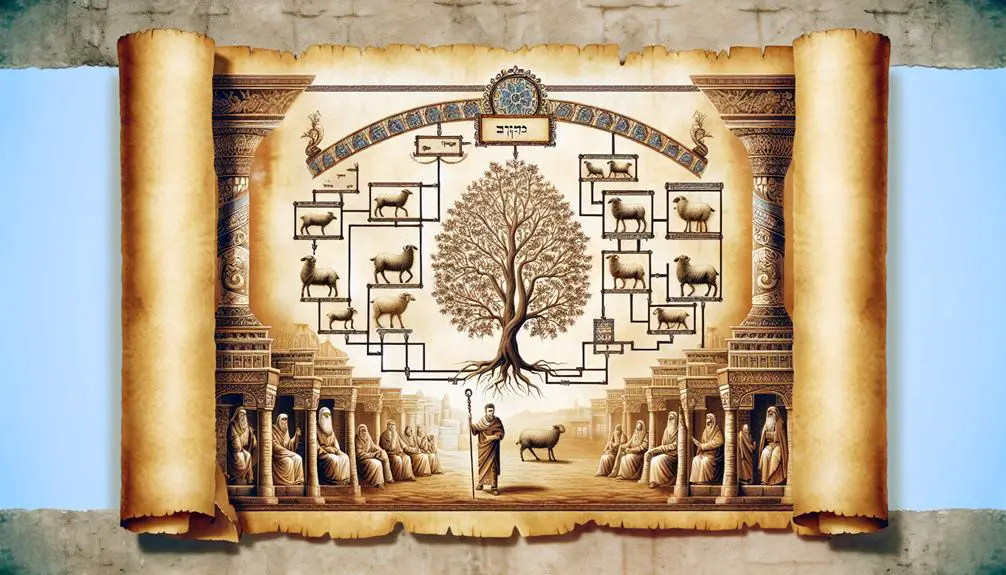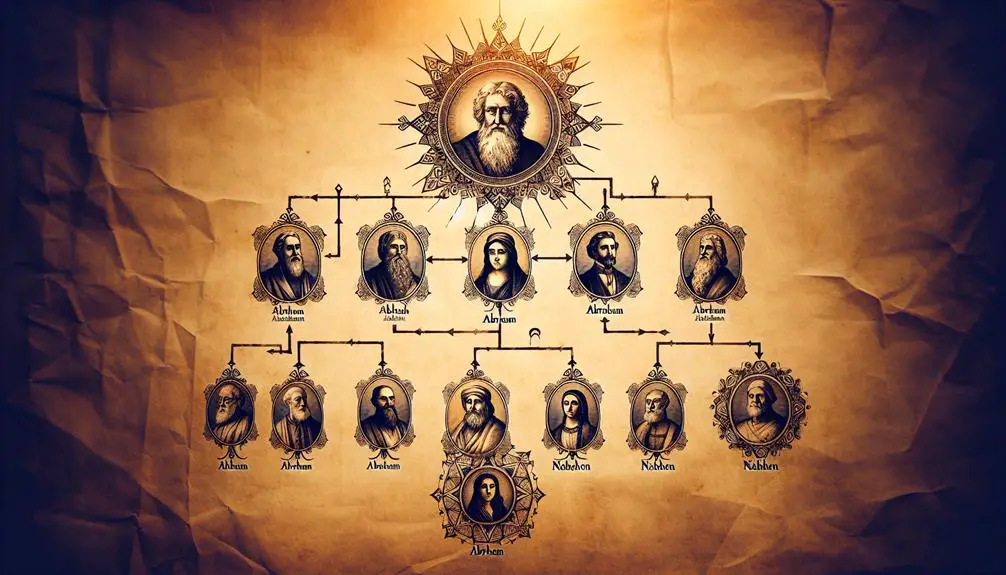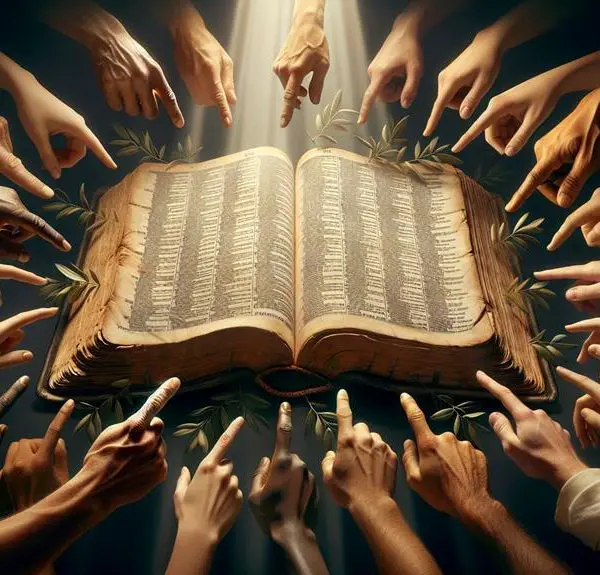Hidden in plain sight, discover where Nahshon's significant yet overlooked biblical journey unfolds, from Exodus to Matthew's genealogy of Jesus.

Where Is Nahshon Mentioned in the Bible
You might think Nahshon is a hidden secret in the vast ocean of Biblical characters, barely making a ripple in the grand narrative. However, he's mentioned in several key sections, including Exodus, Numbers, and even in the New Testament's Gospel of Matthew, tracing his lineage directly to Jesus.
From leading tribal offerings to being counted in censuses, Nahshon's roles are diverse, hinting at a deeper significance that's often overlooked. As you explore further, you'll uncover how his legacy is woven into the fabric of biblical history, offering insights into leadership, faith, and the importance of genealogies in understanding the bigger picture.
Key Takeaways
- Nahshon is highlighted in the Book of Numbers for his leadership role and genealogical significance within the tribe of Judah.
- His contributions and tribal offerings are detailed in census records, showcasing his importance in Israelite society.
- Nahshon's faith-based leadership approach is exemplified during the Exodus, guiding the Israelite community through challenges.
- He is part of Jesus' genealogy in the Gospel of Matthew, linking him to the fulfillment of Old Testament prophecies.
Nahshon in Exodus

Nahshon emerges in the Book of Exodus as a pivotal figure, embodying leadership and faith during a critical period of Israelite history. His narrative is intricately woven into the fabric of the Israelites' desert wanderings, showcasing a character marked by unwavering bravery and a profound commitment to his people. Nahshon's bravery isn't just a footnote in the annals of biblical history; rather, it serves as a cornerstone, illustrating the qualities revered in a leader amidst the tumultuous journey through the desert.
During the desert wanderings, Nahshon's role is emblematic of the resilience and courage required to navigate the uncertainties and adversities faced by the Israelites. His actions, though not always detailed extensively, imply a figure who stood firm in the face of daunting challenges. This period, marked by constant movement and the search for a promised land, demanded leaders who could inspire and sustain faith among the people. Nahshon, as a leader, rose to this occasion, embodying the spirit of determination and hope.
Analyzing Nahshon's contribution during these wanderings offers insights into the dynamics of leadership and faith in ancient Israelite society. His presence underscores the importance of courage and steadfastness, qualities that were essential for survival and cohesion in the harsh desert environment. Nahshon's character becomes a lens through which one can explore the broader themes of leadership, faith, and perseverance that are critical to understanding this epoch of biblical history.
In essence, Nahshon's narrative in Exodus is a testament to the enduring human spirit in the face of adversity. His legacy, marked by bravery and leadership during the desert wanderings, continues to inspire and inform scholarly discussion on biblical leadership paradigms.
Genealogy in Numbers

In the Book of Numbers, the genealogy of Nahshon is meticulously outlined, revealing his prominent position within the tribe of Judah and underscoring his significant role in the lineage of Israel. This detailed account serves not only as a testament to Nahshon's importance but also as a critical piece in understanding the broader context of tribal allocations and census methodology in ancient Israel.
Analyzing the genealogy of Nahshon illuminates the intricate system of tribal hierarchies and allocations that underpinned Israelite society. As a leader within the tribe of Judah, Nahshon's genealogical record is pivotal for scholars seeking to dissect the layers of social and familial organization within the tribes. These records offer a lens through which the complexity of tribal affiliations and the criteria for leadership roles can be explored, shedding light on the mechanisms of governance and social stratification.
Moreover, the inclusion of Nahshon's genealogy within the broader census methodology outlined in Numbers provides valuable insights into the administrative practices of ancient Israel. The meticulous recording of genealogies was integral to the organization of the census, serving both as a means of ensuring the accurate allocation of tribal lands and as a method for maintaining the purity of lineage—a factor of paramount importance in Israelite culture.
Thus, the genealogy of Nahshon stands as a significant element in the study of biblical texts, offering scholars a detailed framework for understanding the complexities of tribal allocations and the sophisticated census methodology that characterized ancient Israelite society. Through this analytical lens, one gains a deeper appreciation for the intricate tapestry of relationships and roles that defined the tribal communities of ancient Israel.
The Census Counts

The census counts, as detailed in the Book of Numbers, provide a meticulous snapshot of ancient Israelite society, reflecting both its structure and the pivotal role of lineage in determining tribal affiliations and leadership hierarchies. Through an examination of these counts, you're able to grasp the immense population significance and the sophisticated recording methods employed by a civilization deeply entrenched in the practices of enumeration and record-keeping.
Here are three critical insights derived from the census counts:
- Population Significance: The census data underscore the scale and distribution of the Israelite population across different tribes. This reveals not just the demographic makeup but also the social and military organization essential for survival and governance in a challenging historical context.
- Recording Methods: The meticulous nature of the census recording methods, which include detailed lists of names and numbers, highlights the ancient Israelites' commitment to accuracy and accountability. This system ensured that tribal affiliations and leadership roles were clearly defined and respected, preventing disputes and fostering unity.
- Lineage and Leadership: The counts serve as a testament to the importance of lineage within Israelite society, where tribal leadership and responsibilities were often inherited. This emphasis on genealogy was crucial for maintaining the social structure and ensuring the continuity of cultural and religious practices.
Offerings and Leadership

You'll find Nahshon's contributions significant both in his offerings and his leadership during the Exodus.
His tribal offering, as detailed in the Scriptures, not only highlights his devotion but also underscores his pivotal role within his community.
Analyzing this aspect sheds light on his leadership qualities, revealing how they were instrumental in guiding his tribe through pivotal moments in their journey.
Nahshon's Tribal Offering
Nahshon's role as a leader is exemplified through his tribal offering, a significant act that underscores his pivotal position within the Israelite community. This offering not only highlights his leadership but also has ceremonial significance, impacting Nahshon's descendants and their standing.
Consider the following aspects of Nahshon's tribal offering:
- Ceremonial Significance: It symbolized dedication and consecration to God, setting a precedent for his descendants.
- Representation of Leadership: Nahshon's offering was a public acknowledgment of his role as a tribal leader, reinforcing his authority.
- Impact on Nahshon's Descendants: This act established a legacy, influencing how future generations viewed and respected his lineage.
Analyzing Nahshon's offering reveals the depth of his influence and the lasting effect on his tribe's spiritual and societal framework.
Leadership Role in Exodus
Building on his role through the tribal offering, Nahshon's leadership during the Exodus further underscores his critical position in guiding and shaping the Israelite community's journey and destiny. His contributions are pivotal, merging Desert Faith with Tribal Dynamics in a manner that not only led his tribe but also set a precedent for leadership among the Israelites.
Aspect |
Impact on Exodus Journey |
|---|---|
Desert Faith |
Strengthened the collective resolve and spirituality |
Tribal Dynamics |
Enhanced cohesion and order among the tribes |
Nahshon's approach to leadership, deeply rooted in faith and an understanding of tribal intricacies, provides a compelling model for navigating challenges. His story exemplifies how faith and leadership can intertwine to steer a community through periods of uncertainty and transformation.
Chronicles and Lineage

You'll find that Nahshon's ancestral role isn't merely a footnote but a cornerstone in the biblical narrative, emphasizing his genealogical significance. Through a detailed examination of Chronicles, you'll uncover how Nahshon's lineage serves as a pivotal connection among various biblical figures and narratives.
This exploration reveals the intricate weave of relationships and roles, underscoring the depth of Nahshon's impact on the fabric of biblical history.
Ancestral Role Highlighted
In examining the biblical Chronicles and lineage records, one quickly realizes that Nahshon emerges as a pivotal figure, anchoring the genealogical framework that links the tribes of Israel with their storied past. His significance is multifaceted, but notably, it underscores:
- Family ties: Nahshon stands at the juncture of familial connections, weaving together generations through bloodlines that are crucial for understanding the social fabric of ancient Israel.
- Tribal importance: As a leader within his tribe, Nahshon's role highlights the intricate relationship between individual tribes and their collective identity, showcasing how lineage and tribal affiliations shape the broader narrative.
- Historical continuity: His mention in the Chronicles serves not just as a genealogical note but as a testament to the enduring legacy of families in maintaining and narrating Israel's history.
Genealogical Significance Explored
Exploring Nahshon's genealogical significance within the Chronicles and lineage records unveils layers of historical and tribal interconnectedness essential for a comprehensive understanding of ancient Israel's societal structure. Nahshon, recognized as a leader within the tribe of Judah, embodies the intricate family dynamics and ancestral importance pivotal to the fabric of communal identity and function.
His placement within the genealogical framework not only emphasizes his role but also illuminates the broader context of lineage and heritage, shaping identities and dictating social hierarchies. This analysis reveals how ancestral narratives and family ties were meticulously recorded, reflecting the value placed on descent and heritage, thereby underscoring the profound impact of genealogy on societal roles and relationships within ancient Israel.
Matthew's Genealogy

Matthew's genealogy meticulously traces Jesus' lineage back to Abraham, revealing a comprehensive list that includes Nahshon among its notable ancestors. This genealogy, presented in the Gospel of Matthew, serves multiple purposes beyond simply listing ancestors. It emphasizes Jesus' rightful place within David's lineage, fulfilling Old Testament prophecies regarding the Messiah's descent. Additionally, Matthew's inclusion of Gentiles in the genealogy underscores the universal scope of Jesus' mission, indicating a breaking down of barriers between Jew and Gentile.
Here are three key aspects to consider:
- David's Lineage: Matthew strategically structures the genealogy to highlight Jesus' connection to King David, placing Nahshon as a pivotal figure in this lineage. Nahshon, recognized as a leader of the tribe of Judah during the Exodus, underlines the royal and messianic expectations tied to Jesus' heritage. This connection is crucial in establishing Jesus' legitimacy as the prophesied king in the line of David.
- Gentile Inclusion: The genealogy uniquely includes several Gentiles, a radical departure from traditional Jewish genealogies. This inclusion signals the Gospel's outreach to all peoples, transcending ethnic and cultural boundaries. It embodies the message that Jesus' mission and salvation are available to everyone, not just the Jewish people.
- Comprehensive List: The list meticulously compiled by Matthew serves as a theological statement, weaving together themes of promise, fulfillment, and universal salvation. It's not just a record; it's a declaration of Jesus' identity and mission.
Matthew's genealogy, therefore, isn't merely a lineage. It's a carefully constructed narrative, embedding deep theological insights and affirming Jesus' role as the promised Messiah for all humanity.
Symbolism and Legacy

Having examined the genealogical context that places Nahshon within Jesus' lineage, let's now focus on the symbolism and legacy this connection fosters, revealing layers of meaning that go beyond mere ancestry. Nahshon's position as a forebear of Christ isn't just a historical footnote; it's a profound statement about divine representation and the continuity of God's work through generations. As a leader of his tribe during the Exodus, Nahshon's faith and actions prefigure the faithfulness and leadership of Jesus Himself. This connection isn't coincidental but a carefully constructed narrative thread that weaves through the tapestry of biblical history, highlighting the deliberate fulfillment of God's promises.
The cultural impact of Nahshon's inclusion in the genealogy of Jesus can't be overstated. It serves as a bridge between the Old and New Testaments, showing that Jesus' roots are deeply embedded in Jewish history and prophecy. This lineage underscores the Messiah's legitimacy within Jewish tradition, reinforcing His role as the ultimate divine representation of God's covenant with Israel.
Moreover, Nahshon's legacy, as it's encapsulated in the genealogy of Matthew, challenges readers to reflect on the implications of divine heritage and the responsibilities it entails. In a broader sense, it invites believers to consider their own place within this ongoing divine narrative, encouraging them to live lives that reflect the faith and leadership exemplified by Nahshon and, ultimately, by Jesus Christ. This symbolic lineage thus serves not only as a historical record but as a continuous call to faith and action in the present.
Frequently Asked Questions
How Does Jewish Tradition Outside of the Bible Further Elaborate on Nahshon's Personality and Contributions to the Israelite Community?
You'll find that Jewish tradition celebrates Nahshon's bravery and leadership traits beyond biblical texts. It portrays him as a pivotal figure, especially during the Israelites' exodus from Egypt.
Traditions highlight his willingness to be the first to step into the Red Sea, demonstrating unmatched faith and courage. This act, among others, solidifies his legacy as a leader who significantly contributed to the Israelite community's survival and morale during their most challenging times.
Are There Any Archaeological Findings or Historical Evidence That Support the Existence of Nahshon or Validate His Role as Described in the Bible?
You're seeking historical validation for Nahshon's existence, specifically through archaeological findings. Unfortunately, direct discoveries of Nahshon's artifacts remain elusive.
Historical validation of biblical figures, including Nahshon, often relies on indirect evidence or broader archaeological context. While you may find tantalizing traces tied to the era, pinpointing artifacts directly to Nahshon proves challenging.
Scholars continue to analyze ancient texts and digs, hoping to uncover more concrete connections to his biblical narrative.
How Do Various Christian Denominations Interpret Nahshon's Significance in the Context of Faith and Theology, Beyond His Genealogical Contribution to the Lineage of Jesus?
You'll find Christian denominations vary in interpreting Nahshon's significance, focusing beyond his genealogical role. They delve into Nahshon's leadership qualities and how these embody faith principles.
Some view him as a model of obedience and courage, pivotal in the faith journey, reflecting a deeper theological significance.
This analysis reveals the diversity in faith interpretations, highlighting different aspects of his leadership as examples of living a life aligned with divine will and purpose.
Has Nahshon Been Depicted in Religious or Secular Art, Literature, or Popular Culture, and if So, What Are Some Notable Examples?
You're exploring whether Nahshon's symbolism has crossed into artistic representations or popular culture.
While not as prominently featured as other biblical figures, his role is subtly influential in religious art and literature.
For example, in medieval Christian art, Nahshon might symbolize faith's lineage, subtly appearing in genealogical depictions.
However, his presence in secular culture is sparse, suggesting a nuanced yet vital role in the tapestry of religious symbolism rather than mainstream recognition.
How Do Contemporary Scholars Reconcile Discrepancies or Debates Surrounding Nahshon's Portrayal in Different Biblical Texts and Translations?
You're diving into how contemporary scholars tackle Nahshon's varying biblical depictions. With over 80% of biblical scholars engaging in textual analysis, they meticulously compare translations, pinpointing discrepancies. This process fuels scholarly debates, pushing for a consensus or acknowledging diverse interpretations.
Through detailed analysis, scholars aim to reconcile these differences, offering a richer understanding of Nahshon's role. Your exploration is at the cutting-edge of biblical scholarship, deciphering ancient texts to uncover historical truths.
Conclusion
In analyzing Nahshon's appearances throughout the Bible, one statistic stands out: he's directly mentioned five times across different books, underscoring his significance in biblical genealogy and leadership narratives.
This frequency not only highlights his pivotal role in Israelite history but also serves as a testament to his enduring legacy.
By examining Nahshon's contributions, from leading tribal offerings to being cited in the genealogy of Jesus, we gain insights into the intricate fabric of biblical history and lineage.



Sign up